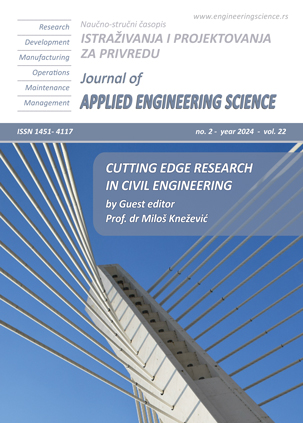PRELIMINARY ANALYSIS OF THE INFLUENCE OF CHANGING DISTANCE BETWEEN PILES ON HORIZONTAL ACCELERATION ELASTIC RESPONSE SPECTRA FOR PILE-SUPPORTED STRUCTURE
Abstract
In the professional literature, the seismic load of pile-supported structure is divided into kinematic seismic load and inertial seismic load from superstructure. Due to the deficiencies in the legal framework in Montenegro (standard MEST EN 1998 - official Montenegrin counterpart of the European seismic standard Eurocode 8), civil engineers when defining seismic load of the pile-supported structure in practice almost every time treat only inertial seismic load from superstructure. Except the problematic neglect of the kinematic seismic load, the way in which the inertial seismic load is defined is also problematic. Due to the deficiencies in the legal framework not only in our country but also worldwide, civil engineers for defining the inertial seismic load of pile-supported structures in practice use elastic and design (inelastic) acceleration response spectra, which are prescribed generally for structures neglecting type of their foundations. This is rather rough and unrealistic assumption. This paper presents part of the results of 2D dynamic analyses of soil-pile-structure interaction, which were performed using the modern Domain Reduction Method, with the aim of preliminary investigating the seismic response of buildings founded on piles. In particular, the presented results show how changing distance between piles affects to the horizontal acceleration elastic response spectra at the base level of analysed pile-supported RC frame. In this way, pile foundation characteristics influence on the intensity of the superstructure seismic load is indirectly analysed. As expected, preliminary analyses have shown that in case of small distance between the piles (2d or 3d), this influence can be very significant. In this specific case, when the piles at the lower end are fixed in the bedrock, that influence is favourable because smaller elastic spectral accelerations are obtained for the complete range of periods (less seismic load of the superstructure). Of course, for some general conclusions and proposals, it is necessary to perform a significantly larger number of dynamic analyses with different configurations and characteristics of the soil-piles-structure system and seismic excitations. It is planned for the next period.
References
Laora, D. R., Mylonakis, G., Mandolini, A. (2019). Size limitations for piles in seismic regions. Earthquake Spectra, 33(2), 729-756. https://doi.org/10.1193/022916EQS029M
Miladinović, B., Živaljević, S., Tomanović, Z. (2023). Kinematičko opterećenje šipova u slučaju pojave likvefakcije u temeljnom tlu tokom zemljotresa. Međunarodna naučna konferencija Planiranje, projektovanje, izvođenje i obnova graditeljstva (INDIS 2023), 116-132, Novi Sad, Serbia.
Emani, P. K., Kumar, R., Vedula, P. (2019). Inelastic response spectrum for seismic soil pile structure interaction. International Journal of Geotechnical Earthquake Engineering, 7(2), 24-34. https://doi.org/10.4018/IJGEE.2019070102
López Jiménez, G. A., Dias, D., Jenck, O. (2019). Effect of the soil-pile-structure interaction in seismic analysis: Case of liquefiable soils. Acta Geotechnica, 14, 1509-1525. https://doi.org/10.1007/s11440-019-00784-3
Miladinović, B. (2023). Preliminarna analiza uticaja promjene nagiba SH talasa na seizmički odgovor sistema tlo-šipovi-konstrukcija uz primjenu metode redukcije domena. Conference Geotehnički aspekti građevinarstva i zemljotresno inženjerstvo. Vrnjačka Banja, Serbia.
Bielak, J., Loukakis, K., Hisada, Y., Yoshimura, C. (2003). Domain reduction method for three-dimensional earthquake modeling in localized regions, Part I: Theory. Bulletin of the Seismological Society of America, 93(2), 817-824. https://doi.org/10.1785/0120020023
Jeremić, B., Yang, Z., Cheng, Z., Jie, G., Tafazzoli, N., Preisig, M., Tasiopoulou, P., Pisano, F., Abell, J., Watanabe, K., Feng, Y., Sinha, S. K., Behbehani, F., Yang, H., Wang, H. (2023). Nonlinear finite elements: Modeling and simulation of earthquakes, soils, structures and their interaction. University of California, Davis, CA, and Lawrence Berkeley National Laboratory, Berkeley, CA.
Miladinović, B. (2023). Domain reduction method: Formulation, possibilities, and examples for analyzing seismic soil-structure interaction. Građevinski materijali i konstrukcije, 66(3), 177-191. https://doi.org/10.5937/GRMK2300009M
Institut za zemljotresno inženjerstvo i inženjersku seizmologiju u Skoplju (IZIIS). (1981). Seizmo-geološke podloge i seizmička mikrorejonizacija urbanog područja Budve – Knjiga II: Inženjersko-seizmološki radovi (IZIIS 81-13).

